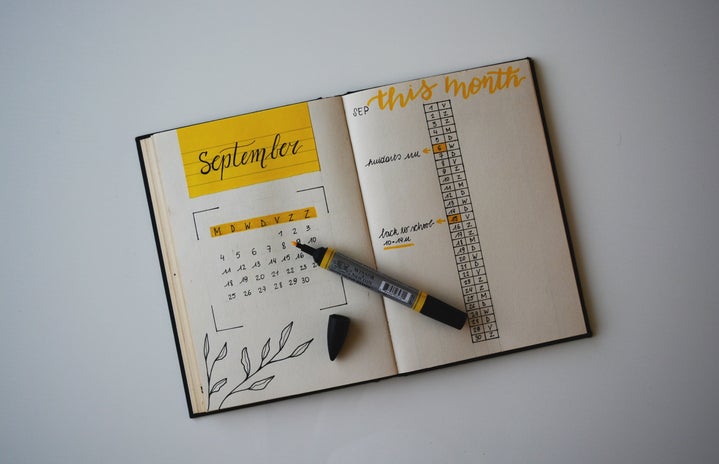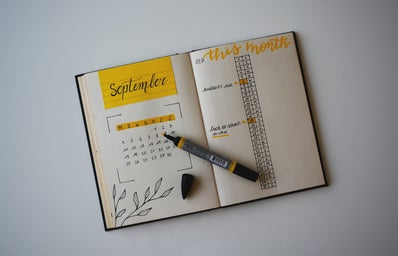With the pressure of real-world events, such as our social life, school, and work, managing all the tasks we have to do can be difficult and suffocating. In a world that is constantly pressuring us to be involved, it is essential that we learn how to keep balance to be on top of everything. Reducing stress comes in many forms and bullet journaling is a traditional way of staying organized.
Bullet journaling is a way for individuals to keep organized by jotting down plans and goals in a singular notebook. Although bullet journaling is seen as a form of art therapy for calligraphy and penmanship enthusiasts, bullet journaling is for everyone at all levels. According to the medical center at the University of Rochester, journaling is a way to deal with common mental illnesses known among college students-and young adults in general- such as depression and anxiety. Journaling can help individuals “gain control of [their] emotions and improve [their] mental health.”
The basics of a Bujo
While professionals and more skilled individuals can make design-heavy spreads, a bullet journal, also known as a bujo, is very simple to create and work with. A bujo can have anything you desire to write down, from daily journal entries to inspirational quotes to important weekly planning.

Common spreadsheets include a yearly, monthly, and weekly calendar view to write down events and schedules, to-do lists, and a goal-planning section. These spreadsheets can be designed in easy formatting such as a quick jotting down sheet or by having a theme/template to make the sheet more interactive in color and design.
The Spreadsheet Ideas
One of the most important ways to start creating a bullet journal is deciding what spreadsheets you want to include throughout your journal. Some people decide to go with the flow and create spreadsheets along the way of designing their journals, while others decide to plan before and properly number their pages: whatever is more beneficial for you is the route you go with when creating your bujo. A bujo is always neater with the first page being a “welcoming” front cover that displays your name and possession of the journal. This helps with showing others who may stumble across your journal to know who is the owner in case it ever gets lost. A front cover is usually followed up with a table of contents or index spread to keep track of the pages.
A bullet journal usually has 2 to 3 sections throughout: 1. the ‘fun’ pages, the ‘work/planning’ pages, and or ‘design’ pages. Fun pages are more interactive and personalized for everyone. Fun pages include spreadsheets for yearly goals, bucket lists, lists of movies to watch and books to read, places to travel to, and more. Ideas for these pages can be found on Pinterest or any bullet journaling guide site.

The planning pages are the main foundation of a bujo: they are the spreadsheets for organizing and can have many templates. This includes creating a “design” cover for every month–usually with a theme related to its season or holiday–and having an overview of the month, a section of notes or to-do list, and then the weekly spreads. There are multiple ways to go about designing a weekly spread: some decide to create text boxes for each day, some use linear notes to separate it into categories, and some follow a timetable for each day. All these forms of a weekly spread can be found on Pinterest, We Heart It, and any bujo account on social media for others to experiment with. Whichever template you choose has its own perks–from being aesthetically pleasing to a more minimal easier to read design.

Design pages are more common among bujo owners who rely on daily inspirational outlets to get through their day. Design pages can be drawings, a puzzle, a section of pictures to look back on, or quotes. Design pages are usually thrown throughout the bullet journal, every month or whenever someone feels like they need a stress reliever in the form of art. Some examples of design pages can be a spreadsheet of Halloween drawings during the last week of October page to pose as an interactive spooky coloring page. Design pages are very similar to “fun” pages in its sense of being more interactive and creative, to focus outside of someone’s daily planning and work.

Bullet journaling is a popular form of notebook planning and organization that allows our creativity to flow. With the variety of pages, designs, and forms of notebook-taking strategies we can use, there are different ways to express ourselves with a bullet journal. Within its simplicity of notebook-taking, bujo designing is for everyone; even with fast bullet note jotters who just like to keep it clean and simple! All you need is a journal with grids or boxes, a pen, and your imagination to get to creating the bujo you have always needed. Get to organizing, bujo enthusiasts!
Sources for all photos: Gabriella Licona
Article Written by Gabriella Licona



